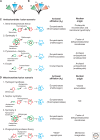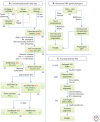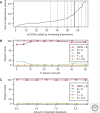The archaeal legacy of eukaryotes: a phylogenomic perspective
- PMID: 24993577
- PMCID: PMC4176008
- DOI: 10.1101/cshperspect.a016022
The archaeal legacy of eukaryotes: a phylogenomic perspective
Abstract
The origin of the eukaryotic cell can be regarded as one of the hallmarks in the history of life on our planet. The apparent genomic chimerism in eukaryotic genomes is currently best explained by invoking a cellular fusion at the root of the eukaryotes that involves one archaeal and one or more bacterial components. Here, we use a phylogenomics approach to reevaluate the evolutionary affiliation between Archaea and eukaryotes, and provide further support for scenarios in which the nuclear lineage in eukaryotes emerged from within the archaeal radiation, displaying a strong phylogenetic affiliation with, or even within, the archaeal TACK superphylum. Further taxonomic sampling of archaeal genomes in this superphylum will certainly provide a better resolution in the events that have been instrumental for the emergence of the eukaryotic lineage.
Copyright © 2014 Cold Spring Harbor Laboratory Press; all rights reserved.
Figures





Similar articles
-
The archaeal 'TACK' superphylum and the origin of eukaryotes.Trends Microbiol. 2011 Dec;19(12):580-7. doi: 10.1016/j.tim.2011.09.002. Epub 2011 Oct 20. Trends Microbiol. 2011. PMID: 22018741
-
The two-domain tree of life is linked to a new root for the Archaea.Proc Natl Acad Sci U S A. 2015 May 26;112(21):6670-5. doi: 10.1073/pnas.1420858112. Epub 2015 May 11. Proc Natl Acad Sci U S A. 2015. PMID: 25964353 Free PMC article.
-
Origin of eukaryotes from within archaea, archaeal eukaryome and bursts of gene gain: eukaryogenesis just made easier?Philos Trans R Soc Lond B Biol Sci. 2015 Sep 26;370(1678):20140333. doi: 10.1098/rstb.2014.0333. Philos Trans R Soc Lond B Biol Sci. 2015. PMID: 26323764 Free PMC article. Review.
-
Asgard archaea illuminate the origin of eukaryotic cellular complexity.Nature. 2017 Jan 19;541(7637):353-358. doi: 10.1038/nature21031. Epub 2017 Jan 11. Nature. 2017. PMID: 28077874
-
The dispersed archaeal eukaryome and the complex archaeal ancestor of eukaryotes.Cold Spring Harb Perspect Biol. 2014 Apr 1;6(4):a016188. doi: 10.1101/cshperspect.a016188. Cold Spring Harb Perspect Biol. 2014. PMID: 24691961 Free PMC article. Review.
Cited by
-
Breath-giving cooperation: critical review of origin of mitochondria hypotheses : Major unanswered questions point to the importance of early ecology.Biol Direct. 2017 Aug 14;12(1):19. doi: 10.1186/s13062-017-0190-5. Biol Direct. 2017. PMID: 28806979 Free PMC article. Review.
-
Archaea and the origin of eukaryotes.Nat Rev Microbiol. 2017 Nov 10;15(12):711-723. doi: 10.1038/nrmicro.2017.133. Nat Rev Microbiol. 2017. PMID: 29123225 Review.
-
Close encounters of the third domain: the emerging genomic view of archaeal diversity and evolution.Archaea. 2013;2013:202358. doi: 10.1155/2013/202358. Epub 2013 Nov 19. Archaea. 2013. PMID: 24348093 Free PMC article. Review.
-
Origins and evolution of viruses of eukaryotes: The ultimate modularity.Virology. 2015 May;479-480:2-25. doi: 10.1016/j.virol.2015.02.039. Epub 2015 Mar 12. Virology. 2015. PMID: 25771806 Free PMC article. Review.
-
Complex archaea that bridge the gap between prokaryotes and eukaryotes.Nature. 2015 May 14;521(7551):173-179. doi: 10.1038/nature14447. Epub 2015 May 6. Nature. 2015. PMID: 25945739 Free PMC article.
References
-
- Bell PJ 2001. Viral eukaryogenesis: Was the ancestor of the nucleus a complex DNA virus? J Mol Evol 53: 251–256 - PubMed
-
- Bult CJ, White O, Olsen GJ, Zhou L, Fleischmann RD, Sutton GG, Blake JA, FitzGerald LM, Clayton RA, Gocayne JD, et al. 1996. Complete genome sequence of the methanogenic archaeon, Methanococcus jannaschii. Science 273: 1058–1073 - PubMed
-
- Cavalier-Smith T 1989. Molecular phylogeny. Archaebacteria and Archezoa. Nature 339: l00–101 - PubMed
Publication types
MeSH terms
Grants and funding
LinkOut - more resources
Full Text Sources
Other Literature Sources
